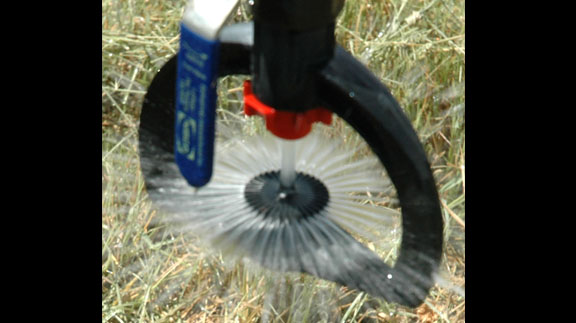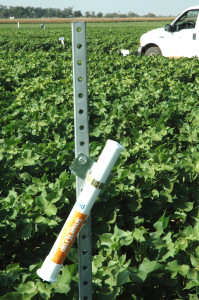Farm & Ranch
[AgriLife Today] Water conservation policy effectiveness depends on farmer economics

New sprinkler emitters may help farmers improve water efficiency on crops, but not necessarily save water in the long run. (Texas A&M AgriLife Communications photo by Kay Ledbetter)
By: Kay Ledbetter
Writer: Kay Ledbetter, 806-677-5608, [email protected]
Contacts: Dr. Seong Park, 940-552-9941, [email protected]
VERNON – Farming is a business, and the actions of farmers will be based on economics – even when it comes to water conservation, according to a recent study by Texas A&M AgriLife Research.
Extremely small recharge rates in the Ogallala Aquifer indicate depletion is inevitable, and that has policymakers scrambling to find ways to prolong its life and ensure a smooth transition to the dryland production to minimize impacts on the overall economy, said Dr. Seong Park, AgriLife Research economist in Vernon.
Park said, however, not all tools proposed or implemented by policymakers will be effective in working toward that goal.
The paper, “Will farmers save water? A theoretical analysis of groundwater conservation policies,” was recently published in the Water Resources and Economics journal and provides a look at the alternatives being offered and their potential to conserve water.
The study was conducted by Park; Dr. Tong Wang, former AgriLife Research post-doctoral researcher now in the South Dakota State department of economics, Brookings, South Dakota; and Dr. Hailong Jin, in the Black Hills State University College of Business and Natural Sciences, Spearfish, South Dakota. Funding was provided through the U.S. Department of Agriculture-Agricultural Research Service Ogallala Aquifer Program.
Using the Ogallala Aquifer as an example, their paper analyzes whether current and potential groundwater conservation policies across the Southern Great Plains provide profit-driven farmers with incentives to save water.

New sensor tools help farmers improve water efficiency on crops, but may not conserve water in the long run, according to a recent Texas A&M AgriLife Research study. (Texas A&M AgriLife Communications photo by Kay Ledbetter)
“We wanted to focus on the incentives provided by selected policy tools to ensure water savings on the farmer’s side and achieve the sustainability goal,” Park said.
He said their theoretical study of the impacts of different policy options on groundwater conservation potential was conducted after previous studies determined voluntary and incentive-based water conservation programs may have “unintended or even perverse consequences.”
“Very few attempts had been made to analyze the effectiveness of different policy alternatives in incentivizing an individual farmer to actually save water,” Park said. “We also wanted to look at the effectiveness of the alternatives based on regional characteristics such as groundwater depth, satiation thickness and feasible crop patterns.”
He said a majority of existing literature modeled the future depletion rate of the Ogallala Aquifer from the perspective of a regulatory agency that can allocate water use effectively and in an efficient manner.
However, farmers tend to make short-term decisions in response to current output prices and input costs without considering long-term profit consequences.
“What we found was that in order to achieve the water-saving goals in regions with high pumping cost, rather than providing a subsidy for the new technology installation or charging a unit water tax, policymakers should offer a unit subsidy for saved water and a subsidy for water-conservation crops,” Wang said. “These are more promising to achieve water savings, as it directly rewards farmers for actual water saved.”
Water rights retirement programs or water buyout programs are an example of providing compensation on a land basis for farmers willing to retire their water right, she said.
“However, our results show a fixed compensation rate tends to attract the land with low productivity and high water cost, thus compromising the program’s effectiveness because most of the enrolled land initially did not use much irrigation water.”
Wang said conceptual models on farmer incentives rarely take these factors into account, so their study filled in those gaps.
“We studied farmer’s incentive-driven responses to the following policy tools: irrigation technology subsidies, increased water costs, unit subsidies for water savings and subsidies on water-conservative crops,” she said.
Wang said they found in regions with high pumping costs, no water savings will occur after converting to a more efficient technology. Instead, farmers take advantage of the new technology to pursue increased profit.
“While the technology subsidy can be effective in the preventative stage, or before the water table declines too much, it is often unjustified when water depletion is already a serious problem,” she said.
Similarly, they noted, an increase in water cost may serve its purpose if well pumping capacity is not a constraint. However, if well pumping capacity is limited due to falling groundwater levels, the cost increase may not be practical because water usage will not respond to the small price increase.
“To achieve the required water savings goal, it often takes a large price increase, which is detrimental to the farmers’ profit and is likely to be met with resistance on implementation,” Wang said.
“We found that policy alternatives such as a subsidy for unit water saved and price subsidy for water-conservative crops is likely effective in achieving water conservation even in the case of high pumping costs,” she said. “Therefore, in areas where groundwater is already a constraint, these direct rewards serve the conservation purpose better.”
Compared to the subsidy of new technology, a subsidy for water saved discourages the farmer from using the saved water to gain additional profit, while a subsidy for water-conservative crops discourages farmers from switching to more water-intensive crops, Wang said.
Beyond the policy implications, the researchers questioned: Among the farmers who adopt more efficient technologies, is there any relationship between water-use adjustment and pumping cost? And, prior to the enrollment, is the average irrigation amount of the land enrolled in a water buyout program comparable to that of the land outside of the program?
Park said future studies should examine the relationship between water pumping cost, crop price and crop patterns to identify the proper price subsidy to more water-conservative crops to achieve the water conservation goal.
“Theoretical modeling from the farmer’s standpoint as well as empirical studies based on farm-level data in different regions could provide policymakers with more detailed information on the extent of water savings by the varied water-conservation policy tools,” he said. “After all, it is the farmers who make the water-conservation decisions.”
The full paper can be found at http://www.sciencedirect.com/science/article/pii/S2212428415300128.
-30-
Find more stories, photos, videos and audio at http://today.agrilife.org
Farm & Ranch
Acorn Toxicity

By Barry Whitworth, DVM, MPH
With the prolonged drought, most pastures in Oklahoma end up in poor condition. With the lack of available forage, animals may go in search of alternative foods.
If oak trees are in the pastures, acorns may be a favorite meal for some livestock in the fall. This may result in oak poisoning.
Oak leaves, twigs, buds, and acorns may be toxic to some animals when consumed.
To read more, pick up a copy of the November edition of North Texas Farm & Ranch magazine, available digitally and in print. To subscribe by mail, call 940-872-5922.

Farm & Ranch
Silver Bluestems

By: Tony Dean
There are a handful of grasses on North Texas grazing lands ranchers need to know, not because they are highly desirable, but rather because they are not of much value. I call them “decom” plants, which is am acronym for “Don’t Ever Count On Me.” Silver bluestem is a “decom” grass.
Silver bluestem is a perennial which grows in all areas of Texas. It can survive in almost all soil types, and in full sun conditions or in semi shade. It grows up to three feet tall and is easily recognized with the presence of the white fuzzy seed head. Also, one of the identifying characteristics of Silver bluestem is a bend in the stems at each node, causing the plants to take on a rounded shape as they mature.
To read more, pick up a copy of the November edition of North Texas Farm & Ranch magazine, available digitally and in print. To subscribe by mail, call 940-872-5922.

Farm & Ranch
Meanwhile Back At The Ranch

By: Rayford Pullen
Fall is here which means winter is closing in on us and before we officially get into winter, we need to make sure our factories are either producing or will be producing in a few months.
We have been pregnancy testing our cows this fall and if they are not bred or nursing a calf, we are bidding them adios. With annual costs somewhere between $900.00 and $1,000.00 per cow, those cows not producing a live weaned calf are costing us quite a bit.
To read more, pick up a copy of the November edition of North Texas Farm & Ranch magazine, available digitally and in print. To subscribe by mail, call 940-872-5922.
-

 Country Lifestyles2 years ago
Country Lifestyles2 years agoScott & Stacey Schumacher: A Growth Mindset
-

 Country Lifestyles8 years ago
Country Lifestyles8 years agoStyle Your Profile – What your style cowboy hat says about you and new trends in 2017
-

 HOME8 years ago
HOME8 years agoGrazing North Texas – Wilman Lovegrass
-

 Equine1 year ago
Equine1 year agoThe Will to Win
-

 Country Lifestyles5 years ago
Country Lifestyles5 years agoAmber Crawford, Breakaway Roper
-

 Outdoor9 years ago
Outdoor9 years agoButtercup or Primrose?
-

 Country Lifestyles8 years ago
Country Lifestyles8 years agoJune 2016 Profile – The man behind the mic: Bob Tallman
-

 Country Lifestyles8 years ago
Country Lifestyles8 years agoDecember 2016 Profile, Rusty Riddle – The Riddle Way




